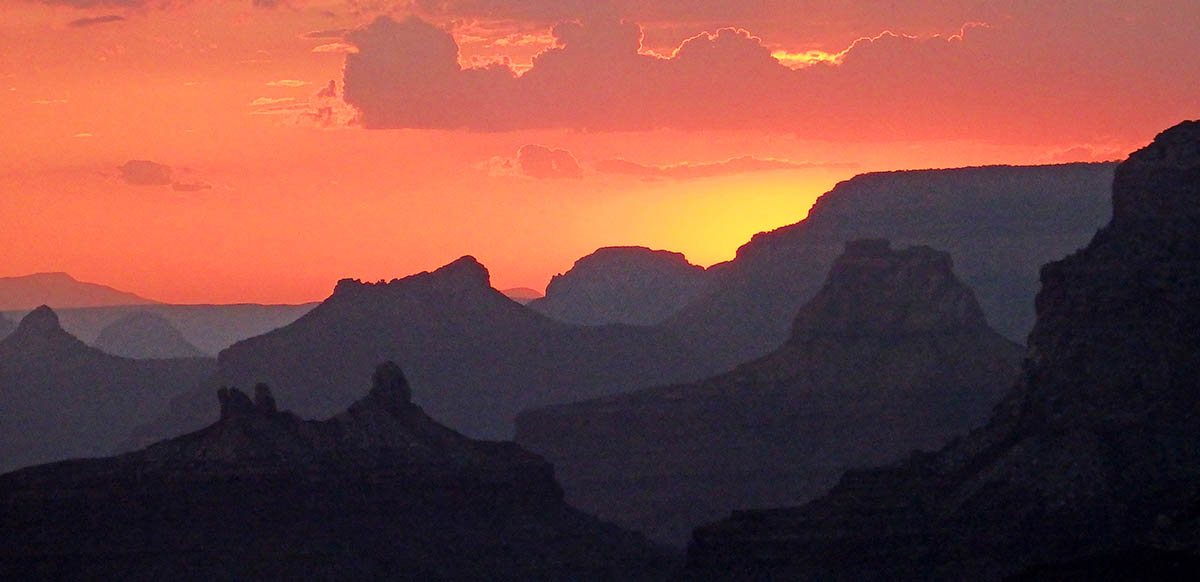
"The rocks are chiefly variegated shades of beautiful colors –creamy orange above, then bright vermilion, and below, purple and chocolate beds, with green and yellow sands." With words like these, Major John Wesley Powell steered his Colorado River Journal in the direction of literature. We would call a good story like his 1869 Grand Canyon adventure a 'colorful yarn'. The faint suggestion of falsehood in that phrase is telling, though –there has never been an accurate way to determine if we all see the same thing. The existence of color blindness suggests that there may be slight differences in everyone's vision.
This Canyon gives us that example every day, all day, from before dawn to after sunset, and though we stare and stare, and click shutters endlessly, and marvel at the changing and deepening hues, we usually look without full awareness. Your camera lens records a slightly different palette of reds, yellows, and blues than mine does. And both are substantially different from what your eyes tell you is there. Stop now, kids. You may not want to compare - it makes you happy to assume that when you get home, you'll see again just what you saw that magnificent evening.
Your brain is telling you, "Yeah, but he's wrong because at noon when the REAL light is on those Canyon layers, they are their own REAL color. You're assuming that the sun's light determines actuality. But what if our star only gave off the light it gives off an hour before it sets? The 'off-white' Coconino Sandstone would always be that glowing buttery color it takes on at that late hour. ALWAYS. Colors are not real –they depend on light for existence.
Color is described as wavelengths of light emitted, transmitted, or reflected. Boy, that's an emotionless series of words. Yet our brains can't see any of the world's rainbow of shades without attaching emotional baggage to them. Not to mention the rainbow itself, right? Blue is calm, red is strong, black is forbidding. White is for the flag of peace, or surrender. Yellow means "whoa, be careful." These ingrained habits of seeing apparently even cross cultural lines. Is the Grand Canyon seen with such reverent awe partly because a view of it is made up of ALL colors?
Even the names are lovely: Alizarin Crimson, Aquamarine. Cerulean, Carnelian, Coral. Emerald, Ebony, Indigo. Lavender, Maroon, Magenta. Sienna, Vermilion, Violet. Artists paint the Canyon because by doing so they can temporarily be one with these colors and shapes, this glorious landscape.
The artist Josef Albers on how colors interact deceptively with their surroundings –"In visual perception a color is almost never seen as it really is –as it is physically." Watch those red tinted rocks change throughout the evening –that's what he means. When those layers of red that Major Powell saw turn to slate blue, then cobalt, before your eyes, you just learned something about art. As my former Professor Paul Zelanski (a student of Albers) once titled an exhibit of his work, "What do YOU see?"
A photograph is not the truth;it's an imaginary portrayal of an object or place. Why is this important? Well, are these words the truth? I would suggest that the fact that we cannot trust that we see the same thing, or even trust what we ourselves see, plays a role as metaphor for the rest of life. We are flawed creatures, easily fooled.
Return to Inspiration Point Blog Index Page.
This blog is meant to encourage awareness and thoughtfulness about the Grand Canyon, one of our most precious resources. It is not merely a story of what happens or has happened here, not a cookbook for what you should make of it yourself, but more an example of the many-faceted inspiration the Canyon nurtures in an artist, perhaps in you. Indeed, inspiration may be the Canyon's greatest resource. These words are sincere, my own take on this world, deliberately non-academic and directed toward users of social media. In no way does it represent the policies or opinions of the National Park Service, although it is done under the auspices of that entity, but is offered in gratitude, with my respect and admiration for these soldiers of conservation. George H. Jacobi 2016
